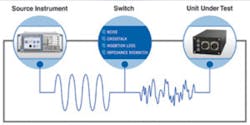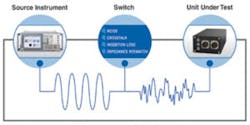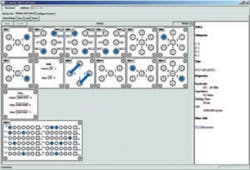In today’s global economy, manufacturers rely increasingly on engineering teams and production facilities spread across the world. A properly architected ATE test strategy can have a significant impact on your organization’s bottom line and reputation. Some of the most common considerations that occur during development of a test strategy include the following:
- Containing capital investments and development costs.
- Sharing ATE development efforts across the entire corporation.
- Minimizing test time and meeting production schedules.
- Maintaining a high degree of confidence in the accuracy of the test results.
- Reducing the footprint of a test system to reduce consumption of floor space.
- Mitigating obsolescence by selecting long-term test platforms.
- Facilitating multivendor interoperability through use of open industry standards.
Adopting a top-level strategy that identifies and prioritizes each of the key objectives should be a primary goal when product test is required. Furthermore, this strategy should be based on an approach that leverages a standardized set of hardware and software building blocks that can deliver the required functionality with minimal integration effort.
Standardizing on test instrumentation building blocks promotes reuse of software and hardware that can be shared by the entire corporation from R&D through manufacturing and support. Additionally, this philosophy simplifies maintenance and reduces spares overhead.
Open standard instrumentation interfaces such as LXI, PXI, and VXI, when implemented with flexible software tools including IVI drivers/wrappers, combine to make this vision one step closer to becoming a reality. However, the fundamental challenge occurs when trying to standardize on signal switching and conditioning, synchronized I/O, and hardware interfaces—the common core of the system. These are specific to the device being tested, very I/O dependent, and hard to scale within an ATE system or across a product’s life cycle from design to production to service.
What Is the Common Core in ATE Systems?
The common core is a group of essential signal switching and synchronized instrumentation that can be used across a broad range of test applications. For example, most electronic test applications require signal switching to route power to excite the UUT as well as connect different stimuli and response instrumentation to verify performance.
A common scalable switching core could comprise high current, a high-fidelity signal, and general-purpose signal routing with multiplexers, matrices, and discrete switching. The same can be said for instrumentation where core instrumentation typically includes digitizers, signal sources, signal conditioning, and digital input/output.
A properly architected common core approach can change the way test system development is viewed in the organization, adding value throughout the product’s life cycle. Systems can be easily scaled to test a variety of products ranging from low to high I/O requirements, leveraging initial investments in core hardware and software across multiple programs. This approach reduces overall test development costs while providing exceptional scalability, flexibility, and reusability.
The common core approach also can control costs as test systems age and the service life of equipment is extended. Basing solutions on open-architecture hardware and software can ensure a smooth transition when hardware becomes obsolete or unable to address expanded test requirements. Test program set (TPS) requalification can be minimized by limiting the impact that any single device will have on the system when updates or replacements are made.
So where does the process begin when you are tasked with defining a common core, and is there a key functional area that cannot be overlooked?
The Challenges of Creating a Common Core
An effective common core strategy must address several fundamental challenges that encompass both hardware and software.
Ensuring Signal Integrity Within the Switching System: Treating the Switch as an Instrument
Signal switching is at the heart of every ATE system and an essential building block for any common core development activity. System-level performance will only be as good as the core switching solution. Accordingly, the switching core should be considered as a fundamental building block and an extension of the instrumentation. If signal integrity is not maintained between the source and measurement device, inaccuracies will affect the test outcome.
Figure 1. Lack of Signal Switching Transparency
Switching is more than a collection of relays on a module or modules in a mainframe. Significant time and expense can result if the UUT either passes or fails because of inaccuracies generated internally in the core switch and interconnect device (Figure 1).
High-quality core switching solutions must incorporate the following characteristics:
- Integrated shield planes to guard against noise and interference.
- Impedance matching throughout the entire signal path to guard against signal reflections.
- Trace separation to minimize crosstalk and maximize isolation.
- Robust connectors to ensure signal connections.
- High-density layout to reduce the footprint.
Viewing the switching core as an extension of the instrumentation and identifying this as a critical system-level requirement will improve overall performance and maximize test effectiveness.
All system functionality is controlled through signal routing including UUT power, fault simulation, stimulus generation, and response measurement. Each of these signal types has unique characteristics that must be carefully considered when selecting the signal routing solution.
A typical switching core comprises different topologies, each designed to address specific system-level requirements. The main types of switch configurations are general-purpose SPST, SPDT, and DPDT; multiplexers; matrixes; and trees.
Seamless Scalability: Seamless Expansion from R&D to the Field
The common core switching system is the most effective way to expand capabilities as a product migrates through different life cycle stages or when new test requirements arise. If additional measurement capabilities are needed, purchasing multiple instruments is neither practical nor cost-efficient.
Expanding core switching capabilities provides the most cost-effective way to increase overall system-level capabilities. Switch modules seamlessly raise the hardware channel count, independent of the chassis size or layout, providing the capability to maximize development activities with minimal effort and without redesign. Flexible software tools expand the measurement capabilities, effectively growing the available switch points through a transparent interface.
Adopting this approach also ensures that the core system can be easily reconfigured for entirely different products and test requirements. It provides a flexible toolkit of signal-routing alternatives virtually independent of configuration and expansion constraints.
Maximizing Software Development Investment
Software drivers and embedded programming tools must provide the capability to easily adapt to changing test configurations and requirements. This is a critical core characteristic that often is overlooked.
Selecting core switching solutions from manufacturers that offer drivers capable of creating multiple virtual switch systems greatly improves flexibility and simplifies expansion because several different switch configurations generally are combined to achieve the final system-level result.
Virtual switch systems can be implemented within a single mainframe or across multiple mainframes because configuration commands are executed in the application code using IVI connect statements. In other words, a channel on a card in slot 1 can be connected to a channel on a card in slot 3 with a single function call, adding flexibility and reducing programming calls.
Incorporating this type of IVI path-level driver capable of transparently encompassing multiple switch cards in a single chassis or across multiple chassis is essential if the core switch is to provide scalability and solution longevity. Traditional IVI switch implementations only span a single card, greatly reducing the system flexibility and increasing overall complexity.
Maximizing Software Development Investment: Embedded Intelligence
Embedded web interfaces, driven by the adoption of new instrumentation standards such as LXI, now are capable of delivering significant development and support savings, an attribute essential to any common core implementation. VTI Instruments has adopted an approach where path-level switch configurator functionality is embedded on the hardware, similar to intelligence in an appliance, eliminating the need for additional user programming or an expensive switch configuration utility. Configurations can be easily modified, independent of any external software or utilities, which maximizes reusability.
Figure 2. Embedded Web Configuration Utility
These interfaces have been developed to assist customers during the specification and development phase of RF- and microwave-switching design while providing a streamlined process for automatically creating the documentation necessary for long-term product support. The embedded web interface offers intuitive graphical configuration utilities so developers can quickly create a custom assembly with the look and feel of a standard COTS product (Figure 2).
Once the design is complete, custom graphical web-based front panels are generated automatically, permitting the equipment to be monitored and controlled from anywhere in the world. Additionally, interconnect diagrams for simplified path-level programming, bills of material, and fully documented wire lists are created for repeatable product fabrication and support. Leveraging this technology can reduce development time and costs by at least 30% to 60%.
Another benefit is automatic path-level programming enabled by the embedded interface, eliminating time-consuming programming tasks by reducing individual relay closure calls into a single high-level path command. If modifications are made to the switch configuration, new path-level definitions are generated automatically, greatly improving supportability and interface flexibility. Tools such as these have evolved to extend core functionality without expensive rehosting and software validation activities and are primarily driven by manufacturers committed to the adoption of open industry standards and interfaces.
System Longevity: Open Standards Hardware and Software Interfaces
The advantages of adopting an open architecture test platform span hardware and software, providing a wide range of choices not available to those locked into proprietary designs. An open hardware approach guarantees that a well-defined set of signal and interface characteristics has been adopted and that multiple vendors will deliver support and products. This results in reduced cost, extended test system life cycles, and COTS product availability.
Figure 3. Distributed Backplane
The VXIbus is a prime example of the features that can be realized through open architecture designs. This platform continues to evolve by providing viable high-density modular solutions using other open platform interfaces such as LXI. The LXI standard was designed with hardware independence in mind, and this is largely accomplished by leveraging well-established industry standards. The interface is based upon IEEE 802.3, and it is intended to support current and future networks with 10/100/1000Base-T or faster connections. The widespread adoption of LXI instrumentation has emerged as the ideal common core switching and instrumentation solution (Figure 3).
Open software support also plays an important role in reducing development costs and ensuring life cycle management of the core. Software independence is built upon well-defined standards such as plug&play and IVI driver sets. This is further extended into the application development environment providing the freedom of choice to select software environments best suited to meet specific needs.
The IVI standard isolates the application code from the specific instrumentation within a system. IVI drivers are divided into various classes based on instrument functionality and build on the plug&play specification by providing features such as state caching that improve system performance. The drivers are intended to allow replacement of one vendor’s instrument with one from another vendor without any modification to application code, an essential attribute of a flexible core solution.
ATML, another emerging standard is focused on simplifying test data collection and sharing. It is an XML-based standard designed to deliver corporate-wide ATE and test information data sharing using a common standard.
With ATML, information can be captured and easily communicated among hardware, software, databases, and the Internet. It also defines external interfaces (schema) for test results, diagnostic information, test configuration, test description, instruments being utilized, UUT data, and interface adapters. While this offers a glimpse at next-generation interoperability, traditional software development approaches still dominate the industry.
Essential Test Strategy
Adopting a top-level scalable common core for ATE strategy offers advantages that can span generations and have a significant impact on your organization’s bottom line and reputation. This strategy should be based on an approach that leverages a standardized set of hardware and software building blocks that can deliver the required functionality with minimal integration and support effort.
Scalable open-architecture hardware and software designs ensure that the common core implementation can evolve to meet changing needs from product development to production and through support in the field. Additionally, long product support cycles can be addressed with minimal exposure to product obsolescence and provide a viable upgrade and expansion path.
About the Author
Jon N. Semancik is the director of corporate marketing and business development at VTI instruments. He has a B.S.E.E. from Fenn College of Engineering and an M.B.A. from the Weatherhead School of Management, Case Western Reserve University. VTI Instruments, 949-955-1894, e-mail: [email protected]



